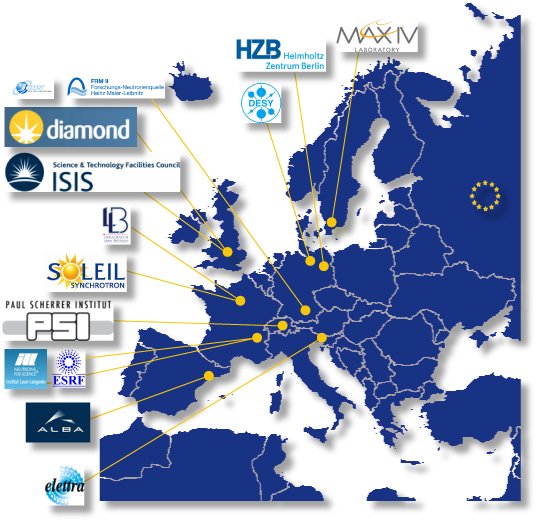 PaNdata brings together thirteen major world class European research infrastructures to create a fully integrated, pan-European, information infrastructure supporting the scientific process. PaNdata launched two projects supported by the European Commision to achieve this long term goal. PaNdata Europe was a pure support activity, laying the foundation for a federated data infrastructure by developing a policy and software framework. This project has been successfully concluded in November 2011. At the same time, the PaNdata Open Data Infrastructure (PaNdata ODI) project has started to work on the implementation of a federated data infrastructure, in particular on software and data catalogues, user identities and authentication systems or optimized data analysis methods, to mention some of the core topics. PaNdata ODI runs until September 2014.
PaNdata brings together thirteen major world class European research infrastructures to create a fully integrated, pan-European, information infrastructure supporting the scientific process. PaNdata launched two projects supported by the European Commision to achieve this long term goal. PaNdata Europe was a pure support activity, laying the foundation for a federated data infrastructure by developing a policy and software framework. This project has been successfully concluded in November 2011. At the same time, the PaNdata Open Data Infrastructure (PaNdata ODI) project has started to work on the implementation of a federated data infrastructure, in particular on software and data catalogues, user identities and authentication systems or optimized data analysis methods, to mention some of the core topics. PaNdata ODI runs until September 2014.
The PaNdata ODI project is co-funded by the partners and the European Commission under the 7th Framework programme Grant Agreement RI-283556
PaNdata ODI
PaNdata Open Data Infratructure is a FP7 (INFRA-2011-1.2.2; Grant Agreement RI-283556) supported project, which started in 11/2011 with the PaNdata ODI kickoff meeting at RAL (see
PaNdata wiki pages for more information). The main goal is the establishment of a data infrastructure, federated among the European Neutron and Photon facilities, to enable the scientific communities access, analysis and sharing of scientific data in a collaborative research environment. For a description of the work packages and contact persons check the
PaNdata ODI Work PackagesPaNdata ODI in brief
PaNdata Open Data Infrastructure is a proposal to construct and operate a sustainable data infrastructure for European Photon and Neutron laboratories. This will enhance all research done in the neutron and photon communities by making scientific data accessible allowing experiments to be carried out jointly in several laboratories. Formed in 2008, the PaNdata collaboration currently brings together eleven major world class European Research Infrastructures to construct and operate a common data infrastructure for the European Neutron and Photon large facilities (See
www.pandata.eu). In 2010, the consortium began a Support Action which is focusing on standardisation activities in the areas of: data policy, user information exchange, scientific data formats, interoperation of data analysis software, and integration and cross-linking of research outputs. These standards form the baseline for PaNdata ODI and will ensure that the research and development activities deliver outputs that can readily be deployed into common services which integrate data across the consortium to create a fully integrated, pan-European, research data infrastructure supporting numerous scientific communities across Europe ...
more
PaNdata Europe
PaN-data Europe was an EU Support Action under INFRA-2010-3.3: Coordination actions, conferences and studies for e-infrastructures. PaN-data Europe is part of the PaN-data international initiative. The project was successfully concluded in 11/2011. For more details, like public deliverables, talks or documents see the
PaNdata wiki pages.
PaNdata Europe in brief
The PaN-data Europe Strategic Working Group (PaN-data Europe) has supported the development of a sustainable data infrastructure for European Neutron and Photon laboratories. The existing PaN-data collaboration aims to develop a common data infrastructure for European Neutron and Photon large facilities. The PaN-data Europe Support Action has supported the integration of this work with the creation of a fully integrated pan-European e-infrastructure supporting all scientific communities.
PaN-data Europe brought together eleven large multidisciplinary Research Infrastructures to construct and operate a common data infrastructure for the European Neutron and Photon large facilities. The PaN-data Europe Support Action has supported the integration of this work with the creation of a fully integrated, pan-European, research and information infrastructure supporting numerous scientific communities across Europe
more
 PaNdata brings together thirteen major world class European research infrastructures to create a fully integrated, pan-European, information infrastructure supporting the scientific process. PaNdata launched two projects supported by the European Commision to achieve this long term goal. PaNdata Europe was a pure support activity, laying the foundation for a federated data infrastructure by developing a policy and software framework. This project has been successfully concluded in November 2011. At the same time, the PaNdata Open Data Infrastructure (PaNdata ODI) project has started to work on the implementation of a federated data infrastructure, in particular on software and data catalogues, user identities and authentication systems or optimized data analysis methods, to mention some of the core topics. PaNdata ODI runs until September 2014.
PaNdata brings together thirteen major world class European research infrastructures to create a fully integrated, pan-European, information infrastructure supporting the scientific process. PaNdata launched two projects supported by the European Commision to achieve this long term goal. PaNdata Europe was a pure support activity, laying the foundation for a federated data infrastructure by developing a policy and software framework. This project has been successfully concluded in November 2011. At the same time, the PaNdata Open Data Infrastructure (PaNdata ODI) project has started to work on the implementation of a federated data infrastructure, in particular on software and data catalogues, user identities and authentication systems or optimized data analysis methods, to mention some of the core topics. PaNdata ODI runs until September 2014.